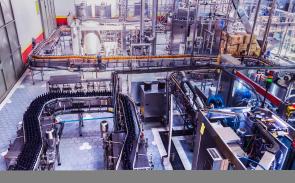Why TSN will soon be a must-have for competitive manufacturing
Futureproof Connected Industries rely on responsive, data-driven operations. Advanced industrial networks that incorporate Time-Sensitive Networking (TSN) are key enablers for such systems. By selecting them, companies can benefit from high-speed, reliable communications for Industry 4.0 applications.
Christian Bergdahl, Product Marketing Manager at HMS Industrial Networks, a member of the CC-Link Partner Association (CLPA), explains why the technology is a gamechanger and how the company is getting ready to launch its first TSN compatible products.
The Connected Industries of the future are highly productive, flexible and responsive because of their ability to leverage the power of data, which can offer a unique understanding of what is happening on the factory floor in real-time. As a result, companies can run automated processes to ensure smooth operations at all times, maximising their efficiency. The backbones of such systems are their networks, which connect every part within a plant or enterprise to share key information. In order to support Industry 4.0 functions, these infrastructures should be able to ensure the large volume of data generated is transmitted with high reliability and in a timely manner. The move towards gigabit bandwidth is further supporting these requirements.
TSN can provide further support and help businesses create data-driven operations. Christian Bergdahl explains: “The most emphasised feature of this technology is its ability to turn standard industrial Ethernet into a real-time communications system with extremely low jitter and latency. Therefore, it provides the key network technology to support the latest data-driven solutions and Industry 4.0 applications. These, in turn, are essential to help companies enhance productivity by creating responsive and flexible shop floors.”
More than simple determinism
He continues: “TSN will make industrial Ethernet deterministic by design and provide the basis of converged networks. In effect, the technology is being defined by the IEEE 802.1 specifications, which will set up a common, unified solution. As a result, any user will be able to benefit from a highly reliable and responsive network, whose nature supports interconnectedness, independently of vendor-specific solutions. This ultimately ensures openness and interoperability among automation devices and systems, simplifying the creation of well-linked plants and enterprises.”
Furthermore, TSN has the ability to bring different parts of an enterprise, such as the operational technology (OT) and information technology (IT) sectors closer together. “The technology was originally developed for transferring audio and video streams in commercial applications. Only later, this solution has been looked at to support industrial automation systems. As a result, TSN applications in a given sector will be influenced by the developments in another segment, shaping and converging the future of the technology and industries themselves,” adds the HMS Industrial Networks specialist. This unique feature will also play a crucial role in enhancing the acceptance of TSN.
No doubt on TSN acceptance
Automation system builders and end users are highly perceptive and well aware of the potential of TSN, particularly its ability to provide a unified way towards interoperability. Therefore, many companies are actively looking forward to adopting this technology. Furthermore, it is a well-accepted concept that TSN will certainly become a must-have in the short- to mid-term. In fact, the extensive roll out of innovative industrial Ethernet solutions is a matter of when, not if - and businesses are ready to act now.
Currently, the creation of TSN-based solutions is experiencing a growth phase and it is certainly a thrilling time for the technology specialists. Christian Bergdahl comments: “Fieldbuses and conventional Ethernet have been established for many years. Now that the innovation of TSN is here, engineers are up for a new challenge as they develop new products with ground-breaking capabilities. It is truly inspiring to see how committed and motivated these teams are.”
Proactive in the development of TSN solutions
A challenge in driving the TSN revolution may be shaping successful collaborations between automation vendors, according to Christian Bergdahl. “As the key element of TSN is interoperability, specialists need to be willing to collaborate closely to develop suitable systems and migration solutions. Within such a framework, existing networks of key automation players, such as the CLPA, are on the right path and have a competitive advantage.
“Being part of the CLPA has always been extremely beneficial. With TSN, we are witnessing a number of unique advantages. In addition to being able to rely on a community of leading automation experts, we can be the first to develop TSN-compatible devices by utilising the CC-Link IE TSN specifications. This is the first network technology incorporating the innovative TSN standards that was released to the market. By offering the earliest solutions with TSN, we can enhance our role and acceptance in the automation sector, particularly in Asia, where the CLPA’s technologies are de facto standards. The first product appearing from HMS in mid-2021 will be the Anybus CompactCom for CC-Link IE TSN, which will allow device makers to easily implement this new promising technology.”
About The CC-Link Partner Association (CLPA)
The CLPA is an international organisation founded in 2000, now celebrating its 20th Anniversary. Over the last 20 years, the CLPA has been dedicated to the technical development and promotion of the CC-Link family of open automation networks. The CLPA's key technology is CC-Link IE TSN, the world's first open industrial Ethernet to combine gigabit bandwidth with Time Sensitive Networking (TSN), making it the leading solution for Industry 4.0 applications. Currently the CLPA has almost 3,800 member companies worldwide, and more than 2,000 compatible products available from over 340 manufacturers. Around 30 million devices using CLPA technology are in use worldwide.
Further Information:
Website: eu.cc-link.org
LinkedIn: https://www.linkedin.com/company/cc-link-partner-association-europe/
Twitter: twitter.com/cc_linknews
YouTube: youtube.com/user/CLPAEurope
Editorial contact:
DMA Europa Ltd. : Anne-Marie Howe
Tel: +44 (0)1562 751436 Fax: +44 (0)1562 748315
Web: www.dmaeuropa.com Email: anne-marie@dmaeuropa.com
Address: Europa Building, Arthur Drive, Hoo Farm Industrial Estate, Kidderminster, Worcestershire, DY11 7RA, UK
Reader contact:
CLPA-Europe : John Browett
Tel: +44 (0) 7768 338708 Fax: +49 (0) 2102 532 9740
Web: eu.cc-link.org
Email: john.browett@eu.cc-link.org
Address: Postfach 10 12 17 40832 Ratingen Germany

The Connected Industries of the future are highly productive, flexible and responsive because of their ability to leverage the power of data, which can offer a unique understanding of what is happening on the factory floor in real-time. (©istock/GCShutter)

Christian Bergdahl, Product Marketing Manager at HMS Industrial Networks, a member of the CC-Link Partner Association (CLPA).
- Ассоциация Партнеров CC-Link (CLPA)
Сайт членов партнерской ассоциации 



